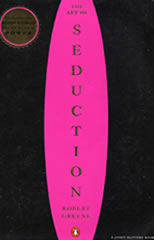
Author : Greene Robert
Title : The Art of Seduction
Year : 2003
Link download : Greene_Robert_-_The_Art_of_Seduction.zip
Preface. Thousands of years ago, power was mostly gained through physical violence and maintained with brute strength. There was little need for subtlety—a king or emperor had to be merciless. Only a select few had power, but no one suffered under this scheme of things more than women. They had no way to compete, no weapon at their disposal that could make a man do what they wanted—politically, socially, or even in the home. Of course men had one weakness: their insatiable desire for sex. A woman could always toy with this desire, but once she gave in to sex the man was back in control; and if she withheld sex, he could simply look elsewhere—or exert force. What good was a power that was so temporary and frail? Yet women had no choice but to submit to this condition. There were some, though, whose hunger for power was too great, and who, over the years, through much cleverness and creativity, invented a way of turning the dynamic around, creating a more lasting and effective form of power. These women—among them Bathsheba, from the Old Testament; Helen of Troy; the Chinese siren Hsi Shi; and the greatest of them all, Cleopatra—invented seduction. First they would draw a man in with an alluring appearance, designing their makeup and adornment to fashion the image of a goddess come to life. By showing only glimpses of flesh, they would tease a man's imagination, stimulating the desire not just for sex but for something greater: the chance to possess a fantasy figure. Once they had their victims' interest, these women would lure them away from the masculine world of war and politics and get them to spend time in the feminine world—a world of luxury, spectacle, and pleasure. They might also lead them astray literally, taking them on a journey, as Cleopatra lured Julius Caesar on a trip down the Nile. Men would grow hooked on these refined, sensual pleasures—they would fall in love. But then, invariably, the women would turn cold and indifferent, confusing their victims. Just when the men wanted more, they found their pleasures withdrawn. They would be forced into pursuit, trying anything to win back the favors they once had tasted and growing weak and emotional in the process. Men who had physical force and all the social power—men like King David, the Trojan Paris, Julius Caesar, Mark Antony, King Fu Chai—would find themselves becoming the slave of a woman. In the face of violence and brutality, these women made seduction a sophisticated art, the ultimate form of power and persuasion. They learned to work on the mind first, stimulating fantasies, keeping a man wanting more, creating patterns of hope and despair—the essence of seduction. Their power was not physical but psychological, not forceful but indirect and cunning. These first great seductresses were like military generals planning the destruction of an enemy, and indeed early accounts of seduction often compare it to battle, the feminine version of warfare. For Cleopatra, it was a means of consolidating an empire. In seduction, the woman was no longer a passive sex object; she had become an active agent, a figure of power. With a few exceptions—the Latin poet Ovid, the medieval troubadours—men did not much concern themselves with such a frivolous art as seduction. Then, in the seventeenth century came a great change: men grew interested in seduction as a way to overcome a young woman's resistance to sex. History's first great male seducers—the Duke de Lauzun, the different Spaniards who inspired the Don Juan legend—began to adopt the methods traditionally employed by women. They learned to dazzle with their appearance (often androgynous in nature), to stimulate the imagination, to play the coquette. They also added a new, masculine element to the game: seductive language, for they had discovered a woman's weakness for soft words. These two forms of seduction—the feminine use of appearances and the masculine use of language—would often cross gender lines: Casanova would dazzle a woman with his clothes; Ninon de l'Enclos would charm a man with her words. At the same time that men were developing their version of seduction, others began to adapt the art for social purposes. As Europe's feudal system of government faded into the past, courtiers needed to get their way in court without the use of force. They learned the power to be gained by seducing their superiors and competitors through psychological games, soft words, a little coquetry. As culture became democratized, actors, dandies, and artists came to use the tactics of seduction as a way to charm and win over their audience and social milieu. In the nineteenth century another great change occurred: politicians like Napoleon consciously saw themselves as seducers, on a grand scale. These men depended on the art of seductive oratory, but they also mastered what had once been feminine strategies: staging vast spectacles, using theatrical devices, creating a charged physical presence. All this, they learned, was the essence of charisma—and remains so today. By seducing the masses they could accumulate immense power without the use of force. Today we have reached the ultimate point in the evolution of seduction. Now more than ever, force or brutality of any kind is discouraged. All areas of social life require the ability to persuade people in a way that does not offend or impose itself. Forms of seduction can be found everywhere, blending male and female strategies. Advertisements insinuate, the soft sell dominates. If we are to change people's opinions—and affecting opinion is basic to seduction—we must act in subtle, subliminal ways. Today no political campaign can work without seduction. Since the era of John F. Kennedy, political figures are required to have a degree of charisma, a fascinating presence to keep their audience's attention, which is half the battle. The film world and media create a galaxy of seductive stars and images. We are saturated in the seductive. But even if much has changed in degree and scope, the essence of seduction is constant: never be forceful or direct; instead, use pleasure as bait, playing on people's emotions, stirring desire and confusion, inducing psychological surrender. In seduction as it is practiced today, the methods of Cleopatra still hold. People are constantly trying to influence us, to tell us what to do, and just as often we tune them out, resisting their attempts at persuasion. There is a moment in our lives, however, when we all act differently—when we are in love. We fall under a kind of spell. Our minds are usually preoccupied with our own concerns; now they become filled with thoughts of the loved one. We grow emotional, lose the ability to think straight, act in foolish ways that we would never do otherwise. If this goes on long enough something inside us gives way: we surrender to the will of the loved one, and to our desire to possess them. Seducers are people who understand the tremendous power contained in such moments of surrender. They analyze what happens when people are in love, study the psychological components of the process—what spurs the imagination, what casts a spell. By instinct and through practice they master the art of making people fall in love. As the first seductresses knew, it is much more effective to create love than lust. A person in love is emotional, pliable, and easily misled. (The origin of the word "seduction" is the Latin for "to lead astray") A person in lust is harder to control and, once satisfied, may easily leave you. Seducers take their time, create enchantment and the bonds of love, so that when sex ensues it only further enslaves the victim. Creating love and enchantment becomes the model for all seductions—sexual, social, political. A person in love will surrender. ...

Demolins Edmond - L'éducation nouvelle
Auteur : Demolins Edmond Ouvrage : L'éducation nouvelle Année : 1898 Lien de téléchargement :...














